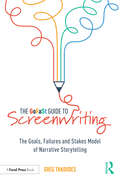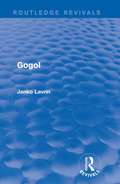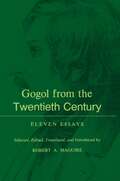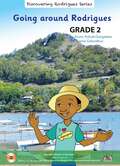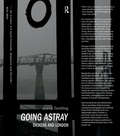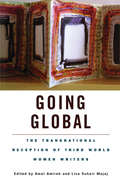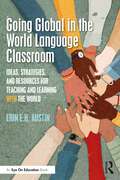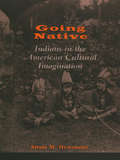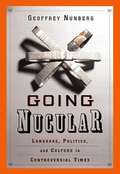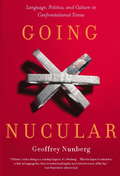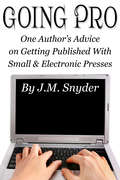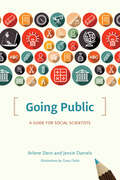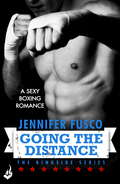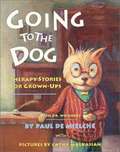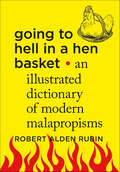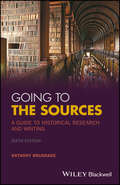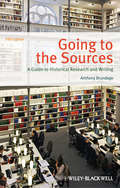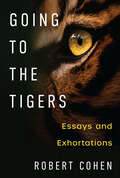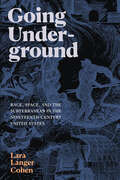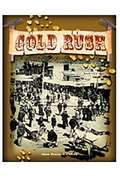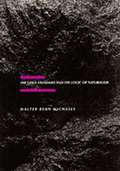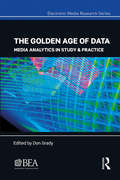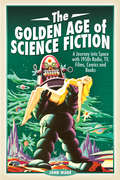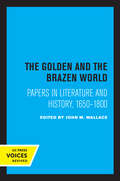- Table View
- List View
The GoFaSt Guide To Screenwriting: The Goals, Failures, and Stakes Model of Narrative Storytelling
by Greg TakoudesCreator of the GoFaSt Model, author Greg Takoudes introduces a comprehensive study of the structural models of screenwriting and provides readers with an adaptive framework for writing successful scripts. With a new approach which reframes discussions and offers alternatives to students and writers who find conventional models creatively constricting, Takoudes draws from both teaching and professional experience to provide a new model of screenwriting that is designed to be adaptive to various types of scripts. The book is structured in three parts. First, it introduces the GoFast Model – allowing for less orthodox writers to keep their unique voices by breaking scripts down into smaller parts and encouraging more flexibility to write in an organized way, without feeling stifled. Second, the book explores several writing scenarios – featuring the practical uses of the model and a step-by-step script structure spanning chapters on a horror, superhero, and heist movie. Third, it concludes with detailed case studies exploring how the GoFaSt Model can be applied to break down scripts including Get Out, The Marvelous Mrs Maisel, and Portrait of a Lady on Fire. It is an ideal text for screenwriting students and aspiring screenwriters interested in learning how working writers put structural models into practice, as well professional screenwriters, producers, and development executives looking for new ways to think about writing, feedback, and development.
Gogol: 1852 (Routledge Revivals #No. 56)
by Janko LavrinThis book, first published in 1926, aimed to introduce to English readers to a great and complex foreign writer in as simple terms as possible. As this was the first extensive study of Gogol in English, the author chiefly considered the general characteristics of the man and his work. This book will be of interest to students of literature.
Gogol From the Twentieth Century: Eleven Essays
by Robert A. MaguireThe description for this book, Gogol From the Twentieth Century: Eleven Essays, will be forthcoming.
Going around Rodrigues class 2 - MIE
by Aruna AnkiahGangadeen and Seema GoburdhunThe book "Going around Rodrigues" is a part of the Literacy Pack series designed by Dr. Aruna Ankiah-Gangadeen and Dr. Seema Goburdhun from the Mauritius Institute of Education. Aimed at young learners, it takes readers on a visual journey through Rodrigues, showcasing its diverse geographical features such as sloping lands, hills, valleys, limestone caverns like Caverne Patate, and picturesque sites like Trou D’Argent beach, Ile aux Cocos, and Ilot Hermitage. Winsley, the protagonist, introduces these scenic spots, emphasizing Mt Limon as the highest mountain. The book emphasizes literacy development by engaging children in pre-reading discussions, guided reading sessions, and post-reading activities. Through interactive learning methods and illustrations, it aims to foster literacy skills while also promoting a deeper understanding of Rodrigues' geography, encouraging a sense of pride and belonging among young readers.
Going Astray: Dickens and London
by Jeremy Tambling'Among the numerous books on Dickens's London, Going Astray is unique in combining detailed topography and biography with close textual analysis and theoretically informed critiques of most of the novelist's major works. In Jeremy Tambling's intriguing and illuminating synthesis, the London A-Z meets Nietzsche, Benjamin and Derrida.' Rick Allen, author of The Moving Pageant: A Literary Sourcebook on London Street-Life, 1700-1914Dickens wrote so insistently about London - its streets, its people, its unknown areas - that certain parts of the city are forever haunted by him. Going Astray: Dickens and London looks at the novelist's delight in losing the self in the labyrinthine city and maps that interest, onto the compulsion to 'go astray' in writing.Drawing on all Dickens' published writings (including the journalism but concentrating on the novels), Jeremy Tambling considers the author's kaleidoscopic characterisations of London: as prison and as legal centre; as the heart of empire and of traumatic memory; as the place of the uncanny; as an old curiosity shop. His study examines the relations between narrative and the city, and explores how the metropolis encapsulates the problems of modernity for Dickens - as well as suggesting the limits of representation. Combining contemporary literary and cultural theory with historical maps, photographs and contextual detail, Jeremy Tambling's book is an indispensable guide to Dickens, nineteenth- century literature, and the city itself.
Going Global: The Transnational Reception of Third World Women Writers (Wellesley Studies in Critical Theory, Literary History and Culture #Vol. 2194)
by Amal Amireh Lisa Suhair MajajFirst published in 2000. Routledge is an imprint of Taylor & Francis, an informa company.
Going Global in the World Language Classroom: Ideas, Strategies, and Resources for Teaching and Learning With the World
by Erin AustinWith this practical resource, you’ll learn how to promote global readiness and build international connections in the world language classroom. Master educator Erin E.H. Austin shares original strategies to facilitate productive language learning and demonstrates how to foster a rigorous, inclusive, and enriching environment. Designed to improve student motivation and engagement, the book is a shift from teaching about the world to teaching with the world. You’ll come away with plenty of inspiring and effective ways to not only invite the world into the classroom but also bring the classroom to the world and, in so doing, support an inviting classroom environment.The book abounds with low-cost, ready-to-implement tools, activities, and lesson ideas. The approaches in this book include coordinating international and world language events at school, using online resources to connect students to new languages and cultures, and broadening student horizons through books and podcasts. Austin also offers ways that further develop students’ global education through travel and study abroad opportunities. With this book, your students will become culturally literate, motivated language learners who will be ready to enter the global community and continue to learn from and with the world.
Going Global in the World Language Classroom: Ideas, Strategies, and Resources for Teaching and Learning With the World
by Erin E.H. AustinWith this practical resource, you’ll learn how to promote global readiness and build international connections in the world language classroom. Master educator Erin E.H. Austin shares original strategies to facilitate productive language learning and demonstrates how to foster a rigorous, inclusive, and enriching environment. Designed to improve student motivation and engagement, the book is a shift from teaching about the world to teaching with the world. You’ll come away with plenty of inspiring and effective ways to not only invite the world into the classroom but also bring the classroom to the world and, in so doing, support an inviting classroom environment. The book abounds with low-cost, ready-to-implement tools, activities, and lesson ideas. The approaches in this book include coordinating international and world language events at school, using online resources to connect students to new languages and cultures, and broadening student horizons through books and podcasts. Austin also offers ways that further develop students’ global education through travel and study abroad opportunities. With this book, your students will become culturally literate, motivated language learners who will be ready to enter the global community and continue to learn from and with the world.
Going Native: Indians in the American Cultural Imagination
by Shari M. HuhndorfSince the 1800's, many European Americans have relied on Native Americans as models for their own national, racial, and gender identities. Displays of this impulse include world's fairs, fraternal organizations, and films such as Dances with Wolves. Shari M. Huhndorf uses cultural artifacts such as these to examine the phenomenon of "going native," showing its complex relations to social crises in the broader American society--including those posed by the rise of industrial capitalism, the completion of the military conquest of Native America, and feminist and civil rights activism. Huhndorf looks at several modern cultural manifestations of the desire of European Americans to emulate Native Americans. Some are quite pervasive, as is clear from the continuing, if controversial, existence of fraternal organizations for young and old which rely upon "Indian" costumes and rituals. Another fascinating example is the process by which Arctic travelers "went Eskimo," as Huhndorf describes in her readings of Robert Flaherty's travel narrative, My Eskimo Friends, and his documentary film, Nanook of the North. Huhndorf asserts that European Americans' appropriation of Native identities is not a thing of the past, and she takes a skeptical look at the "tribes" beloved of New Age devotees. Going Native shows how even seemingly harmless images of Native Americans can articulate and reinforce a range of power relations including slavery, patriarchy, and the continued oppression of Native Americans. Huhndorf reconsiders the cultural importance and political implications of the history of the impersonation of Indian identity in light of continuing debates over race, gender, and colonialism in American culture.
Going Nucular: Language, Politics, and Culture in Confrontational Times
by Geoffrey NunbergNunberg (linguistics, Stanford U.) does not spend much time on the romance of words or decrying the state of the language, but more often takes language as a jumping off point to see what words can reveal about other things, among them culture, war, politics, symbols, media, business, and technology. Many of the 65 essays began life as articles or radio commentaries.
Going Nucular: Language, Politics, and Culture in Confrontational Times
by Geoffrey NunbergThe words that echo through Geoffrey Nunberg's brilliant new journey across the landscape of American language evoke exactly the tenor of our times. Nunberg has a wonderful ear for the new, the comic and the absurd. He pronounces that: "'Blog' is a syllable whose time has come," and that "You don't get to be a verb unless you're doing something right," with which he launches into the effect of Google on our collective consciousness. Nunberg hears the shifting use of "Gallic" as we suddenly find ourselves in bitter opposition to the French; perhaps only Nunberg could compare America the Beautiful with a Syrian national anthem that contains the line "A land resplendent with brilliant suns...almost like a sky centipede." At the heart of the entertainment and linguistic slapstick that Nunberg delights in are the core concerns that have occupied American minds. "Going Nucular," the title piece, is more than a bit of fun at the President's expense. Nunberg's analysis is as succinct a summary of the questions that hover over the administration's strategy as any political insider's. It exemplifies the message of the book: that in the smallest ticks and cues of language the most important issue and thoughts of our times can be heard and understood. If you know how to listen for them. Nunberg has dazzling receptors, perfect acoustics and a deftly elegant style to relay his wit and wisdom.
Going Pro
by J. M. SnyderGoing Pro: One Author’s Advice on Getting Published with Small and Electronic Pressesis a concise guide that offers advice on all aspects of writing for publication. From finding the time to write to finding beta readers, from navigating all the elements of a successful submissions packet to understanding a publishing contract to marketing your newly published book -- here I offer the best advice I can on getting your first story from a file on your computer to an e-book released by a small or electronic press.Topics covered include: polishing your manuscript, finding the right publisher, working with an editor, writing blurbs, and promoting your book. I give detailed explanations of submission guidelines, contracts, rights and copyrights, cover art, and marketing plans. I also offer advice on what to do when things don’t go quite as you plan, whether it’s a bad review or a pirate site, or your publisher folds.It can be intimidating when you’re just starting out and trying to get published. I know, I’ve been there, too. So if you’re interested in getting your stories published with a small press or e-book publisher, let me help you through the process!
Going Public: A Guide for Social Scientists (Chicago Guides to Writing, Editing, and Publishing)
by Arlene Stein Corey Fields Jessie DanielsAt a time when policy discussions are dominated by “I feel” instead of “I know,” it is more important than ever for social scientists to make themselves heard. When those who possess in-depth training and expertise are excluded from public debates about pressing social issues—such as climate change, the prison system, or healthcare—vested interests can sway public opinion in uninformed ways. Yet few graduate students, researchers, or faculty know how to do this kind of work—or feel empowered to do it. While there has been an increasing call for social scientists to engage more broadly with the public, concrete advice for starting the conversation has been in short supply. Arlene Stein and Jessie Daniels seek to change this with Going Public, the first guide that truly explains how to be a public scholar. They offer guidance on writing beyond the academy, including how to get started with op-eds and articles and later how to write books that appeal to general audiences. They then turn to the digital realm with strategies for successfully building an online presence, cultivating an audience, and navigating the unique challenges of digital world. They also address some of the challenges facing those who go public, including the pervasive view that anything less than scholarly writing isn’t serious and the stigma that one’s work might be dubbed “journalistic.” Going Public shows that by connecting with experts, policymakers, journalists, and laypeople, social scientists can actually make their own work stronger. And by learning to effectively add their voices to the conversation, researchers can help make sure that their knowledge is truly heard above the digital din.
Going the Distance: Ringside 2 (Ringside Series #3)
by Jennifer FuscoWelcome to Vegas. You've got ringside seats to the world's hottest boxing match. Watch fearless champions. Meet the women that knock them off their feet. Fans of Katy Evans, Jamie McGuire and RJ Prescott - let's get ready to ruuummble. Middleweight boxer Michael Perez will do whatever it takes to reach the top. With his next fight at Madison Square Garden he's so close - but he needs to drive himself across the country first. When his manager insists a sports reporter tag along, Michael finds himself under the watchful eye of Ava Phillips for the epic road-trip.Ava has made a career out of exposing the underbelly of professional sports. Instinct tells her that Michael's squeaky clean image is a cover - and she's determined to find out more. On the drive from Nevada to New York, things soon start to heat up. But when Ava unearths Michael's past, will she expose his darkness or succumb to pure passion? Ready for round three? Don't miss the third thrilling Ringside book, The Hardest Hit. And return to the world of Stamina in Book One, Fighting For It.
Going To The Dog: Therapy Stories for Grown Ups
by Paul De MielcheFrom Al Rhinoceros to Heather Lamb, Doctor Whiskers, famous dog psychologist, uses animals to tell the story of how people interact with each other and how different techniques can help them feel happy and accepted. This humorous book is as funny as it is insightful, even without access to the illustrations (not described here) that help to describe the story.
Going to Hell in a Hen Basket: An Illustrated Dictionary of Modern Malapropisms
by Robert Alden Rubin“A pain staking but hilarious journey amidst the strings and arrows of language misfortune . . . The result is the perfect gift book for word nerds.” —BrevityMalapropism—A word or phrase that has been mistaken for another, usually because of its sound rather than its meaning.Everyone has made the mistake of using a word or phrase that they think sounds correct, but in fact is not. Malapropisms make some sense. They have a semantic logic to them, even if that logic makes perfect nonsense. In Going to Hell in a Hen Basket, author Robert Alden Rubin delights in the creative misuse of words and celebrates the verbal and textual flubs that ignore the conventions of proper English.Culled from blogs, the deepest corners of the internet, as well as some of the most esteemed publications, here is a collection of classic malapropisms paired with hilarious illustrations.Examples include:adieu, without further—Conflation of bidding adieu (saying goodbye) with ado (complicated doings, ceremony) to mean “without saying anything more.”feeble position—An unborn child in a fetal position seems weak and helpless, which explains the confusion here. The two words also share some sexist cultural and literary associations. Feeble (weak) originates from a Latin word for something to be wept over; fetal (relating to a fetus) originates from the same preliterate Indo-European word that gives us female.Perfect for bookworms and wordsmiths, the point here isn’t to shame the malapropagandists, but to delight in the twists and turns writers put our language through and to amuse and inform those of us who care about words.
Going to the Sources: A Guide to Historical Research and Writing
by Anthony BrundageIt’s been almost 30 years since the first edition of Going to the Sources: A Guide to Historical Research and Writing was first published. Newly revised and updated, the sixth edition of this bestselling guide helps students at all levels meet the challenge of writing their first (or their first “real”) research paper. Presenting various schools of thought, this useful tool explores the dynamic, nature, and professional history of research papers, and shows readers how to identify, find, and evaluate both primary and secondary sources for their own writing assignments. This new edition addresses the shifting nature of historical study over the last twenty years. Going to the Sources: A Guide to Historical Research and Writing includes: A new section analyzing attempts by authors of historical works to identify and cultivate the appropriate public for their writings, from scholars appealing to a small circle of fellow specialists, to popular authors seeking mass readership A handy style guide for creating footnotes, endnotes, bibliographical entries, as well as a list of commonly used abbreviations Advanced Placement high school and undergraduate college students taking history courses at every level will benefit from the engaging, thoughtful, and down-to-earth advice within this hands-on guide.
Going to the Sources
by Anthony BrundageThe updated fifth edition of Going to the Sources presents a practical guide to historical research and writing for all students of history.Focuses on the basics of historians' craft, introducing students to concepts including refining a topic, selecting sources, and engaging critically with their readingAppendices illustrate style for footnotes, endnotes, and bibliographical entries, as well as a list of commonly used abbreviationsFeatures a new chapter on the use of non-textual sources for historians, including a case study discussion of the historical importance of D. W. Griffith's film The Birth of a NationAddresses how to bring the critical assessment skills of reading to bear on film and other non-textual sources Includes a student-written historiographical essay, with marginal notes for instruction
Going to the Tigers: Essays and Exhortations (Writers On Writing)
by Robert CohenIn this funny and perceptive collection, novelist and essayist Robert Cohen shares his thoughts on the writing process and then puts these prescriptions into practice—from how to rant effectively as an essayist and novelist (“The Piano has been Drinking”), how to achieve your own style, naming characters (and creating them), how one manages one’s own identity with being “a writer” in time and space, to the use of reference and allusion in one’s work. Cohen is a deft weaver of allusion himself. In lieu of telling the reader how to master the elements of writing fiction, he shows them through the work of the writers who most influenced his own development, including Bellow, Lawrence, Chekhov, and Babel. Rooted in his own experiences, this collection of essays shows readers how to use their influences and experiences to create bold, personal, and individual work. While the first part of the book teaches writing, the essays in the second part show how these elements come together.
Going Underground: Race, Space, and the Subterranean in the Nineteenth-Century United States
by Lara Langer CohenFirst popularized by newspaper coverage of the Underground Railroad in the 1840s, the underground serves as a metaphor for subversive activity that remains central to our political vocabulary. In Going Underground, Lara Langer Cohen excavates the long history of this now familiar idea while seeking out versions of the underground that were left behind along the way. Outlining how the underground’s figurative sense first took shape through the associations of literal subterranean spaces with racialized Blackness, she examines a vibrant world of nineteenth-century US subterranean literature that includes Black radical manifestos, anarchist periodicals, sensationalist exposés of the urban underworld, manuals for sex magic, and the initiation rites of secret societies. Cohen finds that the undergrounds in this literature offer sites of political possibility that exceed the familiar framework of resistance, suggesting that nineteenth-century undergrounds can inspire new modes of world-making and world-breaking for a time when this world feels increasingly untenable.
Gold Rush (Focus Forward #Green (Level 14))
by Alan Trussell-CullenThe late 1800s was the time of the great gold rushes. The first big gold rush took place in California.
The Gold Standard and the Logic of Naturalism: American Literature at the Turn of the Century
by Walter Benn MichaelsThe Gold Standard and the Logic of Naturalism discusses ways of creating value in turn-of-the-century American capitalism. Focusing on such topics as the alienation of property, the invention of masochism, and the battle over free silver, it examines the participation of cultural forms in these phenomena. It imagines a literary history that must at the same time be social, economic, and legal; and it imagines a literature that, to be understood at all, must be understood both as a producer and a product of market capitalism.
The Golden Age of Data: Media Analytics in Study & Practice (Electronic Media Research Series)
by Don GradyAudience and media analytics is more important now than ever, and this latest volume in the cutting-edge BEA Electronic Media Research Series collects some of the top scholars working with big data and analytics today. These chapters describe the development and help define media analytics as an academic discipline and professional practice. Understanding audiences is integral to creating and distributing media messages and the study of media analytics requires knowing a range of skills including research methods, the necessary tools available, familiarity with statistical procedures, and a mindset to provide insights and apply findings. This book summarizes the insights of analytics practitioners regarding the current state of legacy media analysis and social media analytics. Topics covered include the evolution of media technologies, the teaching of media measurement and analytics, the transition taking place in media research, and the use of media analytics to answer meaningful questions, drive content creation, and engage with audiences.
The Golden Age of Science Fiction: A Journey into Space with 1950s Radio, TV, Films, Comics and Books
by John WadeA detailed look at the British world of science fiction in the 1950s. John Wade grew up in the 1950s, a decade that has since been dubbed the &“golden age of science fiction.&” It was a wonderful decade for the genre, but not so great for young fans. With early television broadcasts being advertised for the first time as &“unsuitable for children&” and the inescapable barrier of the &“X&” certificate in the cinema barring anyone under the age of sixteen, the author had only the radio to fall back on—and that turned out to be more fertile for the budding SF fan than might otherwise have been thought. Which is probably why, as he grew older, rediscovering those old TV broadcasts and films that had been out of bounds when he was a kid took on a lure that soon became an obsession. For him, the super-accuracy and amazing technical quality of today&’s science fiction films pale into insignificance beside the radio, early TV and B-picture films about people who built rockets in their back gardens and flew them to lost planets, or tales of aliens who wanted to take over, if not our entire world, then at least our bodies. This book is a personal account of John Wade&’s fascination with the genre across all the entertainment media in which it appeared—the sort of stuff he reveled in as a young boy—and still enjoys today. &“Not only a well–researched book grounded in hundreds of sources, but also an unmistakable labor of love.&” —New York Journal of Books
The Golden and the Brazen World: Papers in Literature and History, 1650-1800 (Clark Library Professorship, UCLA #10)
by John M. WallaceThis title is part of UC Press's Voices Revived program, which commemorates University of California Press’s mission to seek out and cultivate the brightest minds and give them voice, reach, and impact. Drawing on a backlist dating to 1893, Voices Revived makes high-quality, peer-reviewed scholarship accessible once again using print-on-demand technology. This title was originally published in 1985.
